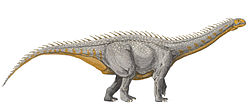Classification
When it was described, Daanosaurus was placed in the Bellusaurinae, a sub-family of Brachiosauridae that Dong Zhiming had raised in 1990 to house Bellusaurus . [1] Bellusaurinae was included in Brachiosauridae based on a historical classification in which Brachiosauridae was used as a catch-all for broad-toothed sauropods, rather than implying close affinities with Brachiosaurus in particular. [2] However, this classification is primarily based on the similarity in size with Bellusaurus. Furthermore, in its original description, Daanosaurus was found not to display any characteristics of the Brachiosauridae. [3] More recently, Daanosaurus was placed in the Macronaria due to its opisthocoelous posterior dorsal vertebrae, [4] but this trait is also present in mamenchisaurids. [5]
Ye and colleagues considered the possibility that Daanosaurus zhangi was based on juvenile material of a mamenchisaurid, but ultimately rejected it. [1] In 2023, as part of a redescription of the mamenchisaurid Mamenchisaurus sinocanadorum, the possibility that Daanosaurus was a mamenchisaurid was tested by phylogenetic analysis. When characters that vary through growth were included in the dataset, both Daanosaurus and Bellusaurus were recovered as mamenchisaurids. The authors found that the characters that supported this hypothesis were only found in mamenchisaurids. The results of the analysis are shown below: [6]
The authors of the study also acknowledged the possibility that Daanosaurus and Bellusaurus may be members of an early-branching group of the Diplodocoidea that shared unique features with mamenchisaurids. Their status as juveniles, the authors noted, was probably the reason to the uncertainty in their phylogenetic position. [6]
This page is based on this
Wikipedia article Text is available under the
CC BY-SA 4.0 license; additional terms may apply.
Images, videos and audio are available under their respective licenses.












